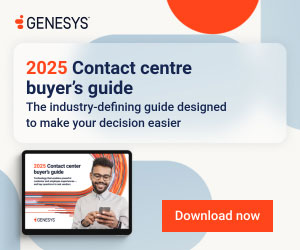Erwan Le Duff of Odigo discusses how you can use technology to manage interactions through one single channel.
Joined-up Thinking in an Increasingly Joined-up World
The evolution of technology has made it possible to manage customer interaction on a single, interconnected channel.
In an era where communication between organisations and their individual customers is fuelling an increased number of interactions, why not use smart technology to take care of your low-complexity cases?
Until only a few years ago, most businesses knew little about their customers, and what they did know would be in departmental silos.
The sales team would perhaps know customer order history, and business-to-business (B2B) salespeople would probably know the key people in procurement roles by name, but that would be about it.
The accounts team would know late payers from good customers, and the marketing department would have a general sense of customer profiles segmented by product line.
What’s more, the kind of interactions to obtain this knowledge was limited—they’d be face-to-face, over the phone or, in more recent years, via the web.
The Bad News …
But now? Now it’s much more complicated. Any customer, commercial or retailer can use several channels of communication to engage with the business: voice via landline or mobile, online via laptop, tablet or smartphone, text messaging via these same different device options, and of course straightforward, old-fashioned, face-to-face conversations.
Online interactions are themselves further segmented via the organisation’s website, its social media feeds and via third parties.
So, for every one of its thousands or possibly millions of customers, an organisation will need to stay on top of multiple individual interactions. In short, customer service just became massive.
… and the Good!
The very technology and its associated interconnectedness that has led to this proliferation of contact has also produced a realistic means of addressing it, even at scale.
First, let’s look at internal processes. Integrated systems using cloud-based models break down these silos, making it much easier to share information between different organisational disciplines.
For instance, people in marketing can now get to know their customers in far more detail, and as a result can furnish their sales colleagues with tailored and compelling propositions.
Then there’s the external process, the customer experience. An interconnected organisation is much better at handling high-volume, multichannel interactions, making the process easier and smoother for customers.
It can do this partly because the technology makes it possible to introduce a “triage” approach, prioritising cases and handling each of them in the most appropriate manner, leveraging a complete vision of the customer’s contact history.
Therefore, in an era where simpler and more efficient communication between organisations and their individual customers are fuelling an increased number of interactions, if it’s impossible to deal with each customer query personally, why not use smart technology to take care of low-complexity cases?
Enter the Bot
Systems are now able to develop knowledge about individual customers and their typical communication paths. For most interactions, automated processes or “bots” can be employed, sourcing responses to an individual customer’s written requests or queries, and replying in the manner of a regular online chat.
These technologies are increasing in sophistication to accommodate voice, so calls can be received and answered using natural language, as though the customer were speaking to a live agent.
What’s more, the system learns. For example, if a person doesn’t at first understand the automated response given, the technology finds a solution and then logs the instance so that next time it will express itself in a different way.
Also, if stress is detected in a caller’s voice, the bot recognises that this is no longer be a low-complexity case and switches the call to a live agent for resolution.
Another example. Odigo have developed a multichannel chatbot for one of France’s biggest healthcare insurers. Operating in text mode as a mobile app but also in voice mode by phone, the technology can identify the customer, understand his or her query via a machine learning engine, narrow down the need using detailed questions and answers, and then deliver a personalised response.
In more tangible terms, if the customer has a new prescription from an eye test, the chatbot can advise what the cost of a new pair of glasses will be within the caller’s healthcare plan and the location of the opticians closest to the customer’s home.
Everyone’s a Winner!
What’s important about these developments is that they’re holistic. The technological evolution that has created customer bases of millions, who engage with your organisation in four, five, six or more different ways.
This evolution also made it possible to ensure that everything acts as one, increasingly sophisticated, automated and highly manageable channel.
It’s Good for Everyone
First and foremost, the needs of the customer are met.
The organisation can handle every interaction in a way that delivers the greatest satisfaction to the customer. And the call centre handling personal voice responses is transformed, adding more value to the customer experience than ever before, and enabling customer service agents to focus on more value added tasks.
It’s joined-up thinking in an increasingly joined-up world!
Author: Robyn Coppell
Published On: 30th May 2019 - Last modified: 19th Jul 2022
Read more about - Guest Blogs, Odigo





































